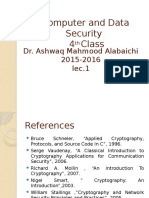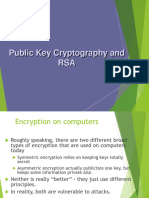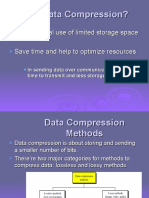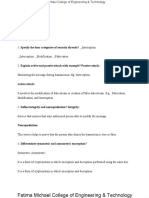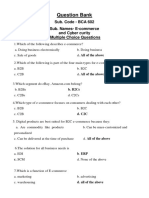Modification of Diffie-Hellman Algorithm
Uploaded by
Anurag TiwariModification of Diffie-Hellman Algorithm
Uploaded by
Anurag TiwariParth Sehgal et.
al / International Journal of Engineering and Technology (IJET)
Modification of Diffie-Hellman Algorithm
to Provide More Secure Key Exchange
Parth Sehgal1,Nikita Agarwal2, Sreejita Dutta3 ,P.M.Durai Raj Vincent 4
1,2,3
IIIrd B.Tech(IT),SITE, VIT University
4
Assistant Professor(Senior), SITE, VIT University.
Parth270592@yahoo.co.in, agarwal.nikita06@gmail.com, sreejita.dutta@gmail.com
Abstract-- Diffie-Hellman algorithm is one of the first schemes proposed for the exchange of keys required
in asymmetric encryption. It was developed by Whitfield Diffie and Martin Hellman in 1976. This
algorithm removes the need of transferring keys between two communicating parties. It enables each
party to generate a shared secret key for encryption and decryption of data. The security of this
algorithm cannot be compromised because several security protocols and services depend upon Diffie-
Hellman key exchange for reliable communication.
In this paper, we have used a random parameter to make this algorithm more efficient. The random
parameter generates new shared keys for each message that is exchanged between sender and receiver.
So, different ciphertext will be produced each time even for the same message. Thus, systems using this
scheme will become more tolerant to various attacks.
I. INTRODUCTION
Cryptography originated many years ago. During its early stages, two parties had to rely on a secure channel for
exchanging a secret key which was used both for encryption and decryption. This scheme is known as private or
symmetric key cryptography [6]. However there were faults in the security of such a scheme. To ensure
complete security, the key should be at least as long as the message as proved by Claude Shannon in the 1940s.
Also, a secure channel is not always available which is why we need such an encryption scheme in the first
place.
These drawbacks can be overcome by using public key cryptography [5]. This scheme enables two
communicating parties to agree upon a shared secret key without exchanging it over the communication
channel. Instead it is derived from parameters all of which are not publicly known.
In 1976, Whitfield Diffie and Martin Hellman who were influenced by the work of Ralph Merkle on public key
distribution, proposed an algorithm for key exchange which uses exponentiation in a finite field [1]. Today,
Diffie Hellman is used in a variety of protocols and services. It is used in interactive transactions, rather than a
batch transfer from a sender to a receiver. The algorithm is used when data is encrypted on the Web using either
SSL or TLS and in VPN. So its security is of utmost importance. However, like other security algorithm it is
vulnerable to various attacks like plaintext attacks, man-in the middle attacks etc. So we propose a modification
of the original algorithm so as make it more tolerant and secure by using a random parameter.
Plaintext attacks are one of the most commonly used cryptanalysis methods. Samples of both the plaintext and
cipher text are available to the attacker. The attacker can deduce more crucial information such as secret keys
and code books from such a collection of known plaintext and cipher text. Due to the random parameter
introduced in the proposed algorithm, the possibility of such a known plaintext attack is greatly reduced [8].
II. THE EXISTING DIFFIE-HELLMAN ALGORITHM
The basic version of the Diffie Hellman algorithm starts with selecting a prime number q and primitive root a
where a<q. The powers of a generates all integers from 1 to q-1, i.e. a mod q, a2mod q, a3 mod q, aq-1 mod
q generate all integers from 1 to p-1.
In this algorithm, first user selects a random natural number i as its private key. The public key for the same
user is calculated as ai mod q. Similarly the second user selects its private key as j. The second users public is
generated in the same way as above. The two users then exchange their public keys. Each user uses its own
private key and the other users public key to compute the shared secret key. Using this secret key,
encryption/decryption takes place.
Algorithm:
1. Select prime number q and its primitive root a (1<= a <=q).
2. User 1:
- Selects pr(1)=i
- pu(1)= ai mod q
3. User 2:
ISSN : 0975-4024 Vol 5 No 3 Jun-Jul 2013 2498
Parth Sehgal et.al / International Journal of Engineering and Technology (IJET)
- Selects pr(2)=j
- pu(2)= aj mod q
4. Both parties exchange public keys.
5. User1:
- Shared secret key, K= pu(2)pr(1)
= aji mod q
6. User 2:
- Shared secret key, K=pu(1)pr(2)
= aij mod q
Only the communicating parties know the private keys i, j as they are not transmitted and cannot be intercepted.
So only the communicating parties can calculate the shared secret key. However there is still no way of
authenticating the communicating parties as their identity is not linked to the keys that they share. So the
algorithm is still prone to man-in-the-middle attacks. To avoid such attacks, public key certificates and digital
signatures can be used, as described in the Authenticated Diffie Hellman Key Agreement Protocol [2].
Also, as the shared key remains constant for a session, the same message when encrypted multiple times will
give the same cryptic text each time. So, frequently occurring patterns in ciphertext can be used to find
relationships between the plaintext and the ciphertext. So, to avoid known plaintext attacks, we introduce a
random factor in the key agreement protocol so that a different ciphertext is generated even for the same
plaintext each time it is encrypted.
III. MODIFICATION TO THE DIFFIE HELLMAN ALGORITHM
Here too, first we select a prime number q and its primitive root a, where a<q.
The first user then selects a random natural number i as its private key. Its public key is calculated as ai mod q.
Similarly, the second user selects a random natural number j as its private key. Its public key is calculated as aj
mod q. The public keys are then exchanged over a public channel. Both users now selects a random integer
t,s, 0<t,s<q.
The random integer t,s is then disguised and exchanged between the two users. The other user can extract the
value of the random integer from the message as they have a knowledge of the private as well as public keys.
The shared secret key is calculated by the first user using its own private key, the second users public key and
the random integers t,s, through exponentiation in a finite field. This secret key is used to encrypt and decrypt
the message.
Algorithm:
1. Select prime number q and its primitive root a (1<= a <=q).
2. User 1:
- Selects pr(1)=i, 0<i<q
- pu(1)= ai mod q
3. User 2:
- Selects pr(2)=j, 0<j<q
- pu(2)= aj mod q
4. Both parties exchange public keys.
5. User 1:
- Selects random integer t, 0<t<q
- Calculate x= pu(1)pr(2)
= aij mod q
- Send t.aijto User 2.
6. User 2:
- Selects random integer s, 0<s<q
- Calculate y= pu(1)pr(2)
= aij mod q
- Send s.aijto User 1.
- Extract t as t=(t.aij)/y
7. User 1:
- Extract s as s=(s.aij)/x
- Shared secret key,
K= pu(2)t.s.pr(1)
ISSN : 0975-4024 Vol 5 No 3 Jun-Jul 2013 2499
Parth Sehgal et.al / International Journal of Engineering and Technology (IJET)
= ats.ji mod q
- Encrypt the plaintext as:
C=E(M,K).
8. User 2:
- Shared secret key,
K=xt.s
= at.s.ji mod q
- Decrypt the cipher text as:
M=D(C,K)
The random factor in the shared secret key, which is different for each message, improvesthe security ofthe
Diffie Hellman algorithm against known plaintext attacks. The same block of text, is encrypted with a different
key each time to generate a new ciphertext each time. So even if an attacker intercepts the messages being
transmitted, he cannot map it to a known set of plaintext and ciphertext. Also, the keys cannot be derived from
such a message.
IV. ANALYSIS AND RESULTS
In a known plaintext attack, a set of plaintext and their corresponding ciphertext is available to the attacker [7].
Using such a set, the attacker can easily find the plaintext if the corresponding ciphertext is present in the set.
Furthermore, an analysis of such a set can determine the shared secret key used in the communication and all
future messages can then be easily decrypted.
This kind of an attack is quite probable if the original Diffie Hellman key exchange protocol is used. However
by introducing a random factor in the calculation of the shared secret key, we can ensure that even if such a set
of plaintext and corresponding ciphertext becomes available to the attacker, no two messages, or two instances
of the same message will have the same corresponding ciphertext. So, the messages cannot be mapped to such a
set to acquire the plaintext. Known plaintext attacks can be avoided thus.
To verify the feasibility of the modified Diffie-Hellman algorithm, we divided the process of converting a
plaintext to ciphertext into three parts, key exchange, encryption and decryption and observed the time taken by
each of these parts to execute individually. The same was done for the original Diffie-Hellman algorithm as
well. We then plotted a graph indicating the total runtime of the existing as well as the proposed Diffie-Hellman
algorithm for different data sizes.
TABLE I: RUNTIME FOR BASIC DIFFIE-HELLMAN ALGORITHM FOR DIFFERENT DATA SIZES.
message size 2 3 4 5
key
exchange (in
ns) 3710170 3609236 4542445 3694773
encryption(in
ns) 872478 679592 760852 729203
decryption(in
ns) 3482037219 4054036323 4696896031 3963999165
total time(in
ns) 3486619867 4058325151 4702199328 3968423141
TABLE II: RUNTIME FOR MODIFIED DIFFIE-HELLMAN ALGORITHM FOR DIFFERENT DATA SIZES.
message size 2 3 4 5
key
exchange (in
ns) 3815381 4375648 4078835 4065148
encryption(in
ns) 1885236 2256040 2445504 2521632
decryption(in
ns) 5604600268 4910492317 5041517974 4511353761
total time(in
ns) 5610300885 4917124005 5048042313 4517940541
ISSN : 0975-4024 Vol 5 No 3 Jun-Jul 2013 2500
Parth Sehgal et.al / International Journal of Engineering and Technology (IJET)
6E+09
5E+09
4E+09 Proposed
3E+09 Algorithm
2E+09 Original
1E+09 Algorithm
0
0 2 4 6
Fig 1. Comparison of runtimes for the proposed algorithm and the original algorithm.
In Figure 1, the x-axis represents the size of the message to be encrypted and the y-axis represents the total time
taken (in nanoseconds) for the process, which includes key generation, encryption and decryption. It is observed
that the execution time of the modified algorithm is greater than that of the existing algorithm.
However, the difference between the two runtimes is very small and is observed to be about 969460064
nanoseconds.
This increase in runtime in case of the proposed algorithm is a small tradeoff for improved security of the
original algorithm. So we can say that it is feasible to introduce the random parameters in the existing Diffie-
Hellman algorithm so as to make it less vulnerable to known plaintext attacks, thereby improving the security of
the algorithm.
V. CONCLUSION
The basic version of Diffie Hellman algorithm faces multiple security threats. The security of the algorithm
depends on the difficulty of solving discrete logarithms and of the integer factorization problem. The security
also depends on the bit length of the keys used [3][4].
In this paper, we have proposed an improvement over the Diffie Hellman Algorithm where a random factor is
introduced in the secret key for each message that is encrypted. So, a new ciphertext is generated even for the
same plaintext each time. This reduces a possibility of a known plaintext attack as explained above.
This security improvement is beneficial because Diffie Hellman Algorithm is the basis of several security
standards and services on the internet, and if the security of the Diffie Hellman algorithm is compromised, such
systems will collapse.
VI. REFERENCES
[1] Diffie W., Hellman M., 1976. New directions in cryptography, IEEE Transactions on Information Theory, volume 22, pages 644-
654.
[2] Diffie, W.; van Oorschot, P. C.; Wiener, M. J. (1992), "Authentication and Authenticated Key Exchanges", Designs, Codes and
Cryptography (Kluwer Academic Publishers) 2: 107125.
[3] Maurer U.M., 1994. Towards the equivalence of breaking the Diffie-Hellman protocol and computing discrete logarithms, 271281.
[4] Francois J., Raymond A., 1998. Security Issues in the Diffie-Hellman Key Agreement Protocol, IEEE Trans. on Information Theory,
pages 117.
[5] Martin E. Hellman May 2002. An Overview of Public Key Cryptography, IEEE Communications Magazine, pages:4249.
[6] Bellare, M., Canetti, R., and Krawczyk, H. Modular approach to the design and analysis of key exchange protocols. In Proceedings of
the 30th Annual ACM Symposium on Theory of Computing (STOC-98) (New York, May 2326 1998),
ACM Press, pages. 419428.
[7] Diffie, Whitfield, and Martin E. Hellman, 1977. "Special feature exhaustive cryptanalysis of the NBS data encryption standard."
Computer 10.6, pages : 74-84.
[8] Diffie, W., & Hellman, M. E. (1979). Privacy and authentication: An introduction to cryptography. Proceedings of the IEEE, 67(3),
pages 397-427.
ISSN : 0975-4024 Vol 5 No 3 Jun-Jul 2013 2501
You might also like
- Proofpoint SER App Onboarding Guide v1.4No ratings yetProofpoint SER App Onboarding Guide v1.44 pages
- 11.3.1.2 Lab - CCNA Security ASA 5505 ComprehensiveNo ratings yet11.3.1.2 Lab - CCNA Security ASA 5505 Comprehensive18 pages
- M S Ramaiah Institute of Technology: Department of Computer Science and Engineering BangaloreNo ratings yetM S Ramaiah Institute of Technology: Department of Computer Science and Engineering Bangalore47 pages
- Modified RSA Public Key Cryptosystem Using Two Key PairsNo ratings yetModified RSA Public Key Cryptosystem Using Two Key Pairs3 pages
- Computer and Data Security 4 Class: Dr. Ashwaq Mahmood Alabaichi 2015-2016 Lec.1No ratings yetComputer and Data Security 4 Class: Dr. Ashwaq Mahmood Alabaichi 2015-2016 Lec.115 pages
- SJB Institute of Technology: Module - 4 Asymmetric CiphersNo ratings yetSJB Institute of Technology: Module - 4 Asymmetric Ciphers82 pages
- Dhanalakshmi College of Engineering, ChennaiNo ratings yetDhanalakshmi College of Engineering, Chennai12 pages
- Exp2 Write a Program to Implement RSA Algorithm and Digital Signature Scheme Using RSA ElGamalNo ratings yetExp2 Write a Program to Implement RSA Algorithm and Digital Signature Scheme Using RSA ElGamal6 pages
- 137 - CS8792, CS6701 Cryptography and Network Security - 2 Marks With Answers 3No ratings yet137 - CS8792, CS6701 Cryptography and Network Security - 2 Marks With Answers 313 pages
- Cryptography and Network Security: Fourth Edition by William StallingsNo ratings yetCryptography and Network Security: Fourth Edition by William Stallings27 pages
- VTU Network Security (10ec832) Unit-2 Notes..100% (3)VTU Network Security (10ec832) Unit-2 Notes..91 pages
- Diffie-Hellman Algorithm: Presented By: Rashi Jain, Kamshin, Saloni, DivyaNo ratings yetDiffie-Hellman Algorithm: Presented By: Rashi Jain, Kamshin, Saloni, Divya17 pages
- ACFrOgBCgjQpFG6KikdOSWdf3r6B5qN07oy2CaHtuuVeo6SX6CnRMNI Jg3qPYdmOwOSg5KxWC54r09E9xjg6Vvv27dKuBN68DKBFk UqQnUF2A4voHOrp - gQcE6VgNo ratings yetACFrOgBCgjQpFG6KikdOSWdf3r6B5qN07oy2CaHtuuVeo6SX6CnRMNI Jg3qPYdmOwOSg5KxWC54r09E9xjg6Vvv27dKuBN68DKBFk UqQnUF2A4voHOrp - gQcE6Vg26 pages
- Fully Collusion Secure Dynamic Broadcast Encryption With Constant-Size Ciphertexts or Decryption KeysNo ratings yetFully Collusion Secure Dynamic Broadcast Encryption With Constant-Size Ciphertexts or Decryption Keys20 pages
- Data Encryption and Decryption Using RSANo ratings yetData Encryption and Decryption Using RSA5 pages
- Comparative Study and Performance Analysis of Encryption in RSA, ECC and Goldwasser-Micali CryptosystemsNo ratings yetComparative Study and Performance Analysis of Encryption in RSA, ECC and Goldwasser-Micali Cryptosystems8 pages
- UNIT-3 (PART-I) (Number Theory) Prime Numbers: A QN + RNo ratings yetUNIT-3 (PART-I) (Number Theory) Prime Numbers: A QN + R29 pages
- 47_Chapter 4 cryptography_and_network securityNo ratings yet47_Chapter 4 cryptography_and_network security12 pages
- MODELING DIFFIE HELLMAN KEY EXCHANGE ALGORITHM USING OBJECT-ORIENTED ANALYSIS AND DESIGN TECHNIQUENo ratings yetMODELING DIFFIE HELLMAN KEY EXCHANGE ALGORITHM USING OBJECT-ORIENTED ANALYSIS AND DESIGN TECHNIQUE8 pages
- Details of Class Representative: Name Sapid Roll No Contact NoNo ratings yetDetails of Class Representative: Name Sapid Roll No Contact No1 page
- Leave Details: Anurag Tiwari 40001462 Comp. of 4-Mar-17 Anurag Tiwari 40001462 Casual Leave 14 March - 18 March 2017No ratings yetLeave Details: Anurag Tiwari 40001462 Comp. of 4-Mar-17 Anurag Tiwari 40001462 Casual Leave 14 March - 18 March 20172 pages
- Learning To Identify Overlapping and Hidden Cognitive Processes From fMRI DataNo ratings yetLearning To Identify Overlapping and Hidden Cognitive Processes From fMRI Data3 pages
- The Mirror Neuron System and Action RecognitionNo ratings yetThe Mirror Neuron System and Action Recognition6 pages
- Design of Line, Circle & Ellipse Algorithms: Larry F. Hodges (Modified by Amos Johnson) 1No ratings yetDesign of Line, Circle & Ellipse Algorithms: Larry F. Hodges (Modified by Amos Johnson) 121 pages
- FortiGate 7.4 Administrator Sample Questions 100%No ratings yetFortiGate 7.4 Administrator Sample Questions 100%9 pages
- Fortinet NSE4 - FGT-6 0 v2019-05-02 PDFNo ratings yetFortinet NSE4 - FGT-6 0 v2019-05-02 PDF47 pages
- 71 Sites like Crackingpatching.com & Alternative - Similar SitesNo ratings yet71 Sites like Crackingpatching.com & Alternative - Similar Sites64 pages
- How To Install Webmin With SSL On Ubuntu 14No ratings yetHow To Install Webmin With SSL On Ubuntu 146 pages
- ScanPlus ATM Terminal Security (TSS) - Comparision SheetNo ratings yetScanPlus ATM Terminal Security (TSS) - Comparision Sheet10 pages
- Mediant 9000 SBC Series Users Manual Ver 74No ratings yetMediant 9000 SBC Series Users Manual Ver 741,645 pages
- Rubrik CDM Version 7.0 Security Guide (Rev. A1)No ratings yetRubrik CDM Version 7.0 Security Guide (Rev. A1)62 pages
- Alcatel-Lucent Enterprise: July 2017 Cto/CtsoNo ratings yetAlcatel-Lucent Enterprise: July 2017 Cto/Ctso20 pages
- Fortinet - NSE4 FGT-7.2.vDec-2023.by .Jakmar.108q100% (1)Fortinet - NSE4 FGT-7.2.vDec-2023.by .Jakmar.108q54 pages
- Presentation - NetworkingTechnologies-Fundamentals N Concepts For BSIT-CT2 - 2014No ratings yetPresentation - NetworkingTechnologies-Fundamentals N Concepts For BSIT-CT2 - 2014113 pages
- Network+ Guide To Networks Eighth Edition: Virtualization and Cloud ComputingNo ratings yetNetwork+ Guide To Networks Eighth Edition: Virtualization and Cloud Computing68 pages
- CIS Oracle Database 12c Benchmark v2.1.0No ratings yetCIS Oracle Database 12c Benchmark v2.1.0297 pages
- SAP Insider - Simple and Secure User Authentication With SAP Single Sign-On 2.0No ratings yetSAP Insider - Simple and Secure User Authentication With SAP Single Sign-On 2.07 pages
- 11.3.1.2 Lab - CCNA Security ASA 5505 Comprehensive11.3.1.2 Lab - CCNA Security ASA 5505 Comprehensive
- M S Ramaiah Institute of Technology: Department of Computer Science and Engineering BangaloreM S Ramaiah Institute of Technology: Department of Computer Science and Engineering Bangalore
- Modified RSA Public Key Cryptosystem Using Two Key PairsModified RSA Public Key Cryptosystem Using Two Key Pairs
- Computer and Data Security 4 Class: Dr. Ashwaq Mahmood Alabaichi 2015-2016 Lec.1Computer and Data Security 4 Class: Dr. Ashwaq Mahmood Alabaichi 2015-2016 Lec.1
- SJB Institute of Technology: Module - 4 Asymmetric CiphersSJB Institute of Technology: Module - 4 Asymmetric Ciphers
- Exp2 Write a Program to Implement RSA Algorithm and Digital Signature Scheme Using RSA ElGamalExp2 Write a Program to Implement RSA Algorithm and Digital Signature Scheme Using RSA ElGamal
- 137 - CS8792, CS6701 Cryptography and Network Security - 2 Marks With Answers 3137 - CS8792, CS6701 Cryptography and Network Security - 2 Marks With Answers 3
- Cryptography and Network Security: Fourth Edition by William StallingsCryptography and Network Security: Fourth Edition by William Stallings
- Diffie-Hellman Algorithm: Presented By: Rashi Jain, Kamshin, Saloni, DivyaDiffie-Hellman Algorithm: Presented By: Rashi Jain, Kamshin, Saloni, Divya
- ACFrOgBCgjQpFG6KikdOSWdf3r6B5qN07oy2CaHtuuVeo6SX6CnRMNI Jg3qPYdmOwOSg5KxWC54r09E9xjg6Vvv27dKuBN68DKBFk UqQnUF2A4voHOrp - gQcE6VgACFrOgBCgjQpFG6KikdOSWdf3r6B5qN07oy2CaHtuuVeo6SX6CnRMNI Jg3qPYdmOwOSg5KxWC54r09E9xjg6Vvv27dKuBN68DKBFk UqQnUF2A4voHOrp - gQcE6Vg
- Fully Collusion Secure Dynamic Broadcast Encryption With Constant-Size Ciphertexts or Decryption KeysFully Collusion Secure Dynamic Broadcast Encryption With Constant-Size Ciphertexts or Decryption Keys
- Comparative Study and Performance Analysis of Encryption in RSA, ECC and Goldwasser-Micali CryptosystemsComparative Study and Performance Analysis of Encryption in RSA, ECC and Goldwasser-Micali Cryptosystems
- UNIT-3 (PART-I) (Number Theory) Prime Numbers: A QN + RUNIT-3 (PART-I) (Number Theory) Prime Numbers: A QN + R
- MODELING DIFFIE HELLMAN KEY EXCHANGE ALGORITHM USING OBJECT-ORIENTED ANALYSIS AND DESIGN TECHNIQUEMODELING DIFFIE HELLMAN KEY EXCHANGE ALGORITHM USING OBJECT-ORIENTED ANALYSIS AND DESIGN TECHNIQUE
- Application and Implementation of DES Algorithm Based on FPGAFrom EverandApplication and Implementation of DES Algorithm Based on FPGA
- Details of Class Representative: Name Sapid Roll No Contact NoDetails of Class Representative: Name Sapid Roll No Contact No
- Leave Details: Anurag Tiwari 40001462 Comp. of 4-Mar-17 Anurag Tiwari 40001462 Casual Leave 14 March - 18 March 2017Leave Details: Anurag Tiwari 40001462 Comp. of 4-Mar-17 Anurag Tiwari 40001462 Casual Leave 14 March - 18 March 2017
- Learning To Identify Overlapping and Hidden Cognitive Processes From fMRI DataLearning To Identify Overlapping and Hidden Cognitive Processes From fMRI Data
- Design of Line, Circle & Ellipse Algorithms: Larry F. Hodges (Modified by Amos Johnson) 1Design of Line, Circle & Ellipse Algorithms: Larry F. Hodges (Modified by Amos Johnson) 1
- 71 Sites like Crackingpatching.com & Alternative - Similar Sites71 Sites like Crackingpatching.com & Alternative - Similar Sites
- ScanPlus ATM Terminal Security (TSS) - Comparision SheetScanPlus ATM Terminal Security (TSS) - Comparision Sheet
- Presentation - NetworkingTechnologies-Fundamentals N Concepts For BSIT-CT2 - 2014Presentation - NetworkingTechnologies-Fundamentals N Concepts For BSIT-CT2 - 2014
- Network+ Guide To Networks Eighth Edition: Virtualization and Cloud ComputingNetwork+ Guide To Networks Eighth Edition: Virtualization and Cloud Computing
- SAP Insider - Simple and Secure User Authentication With SAP Single Sign-On 2.0SAP Insider - Simple and Secure User Authentication With SAP Single Sign-On 2.0


















